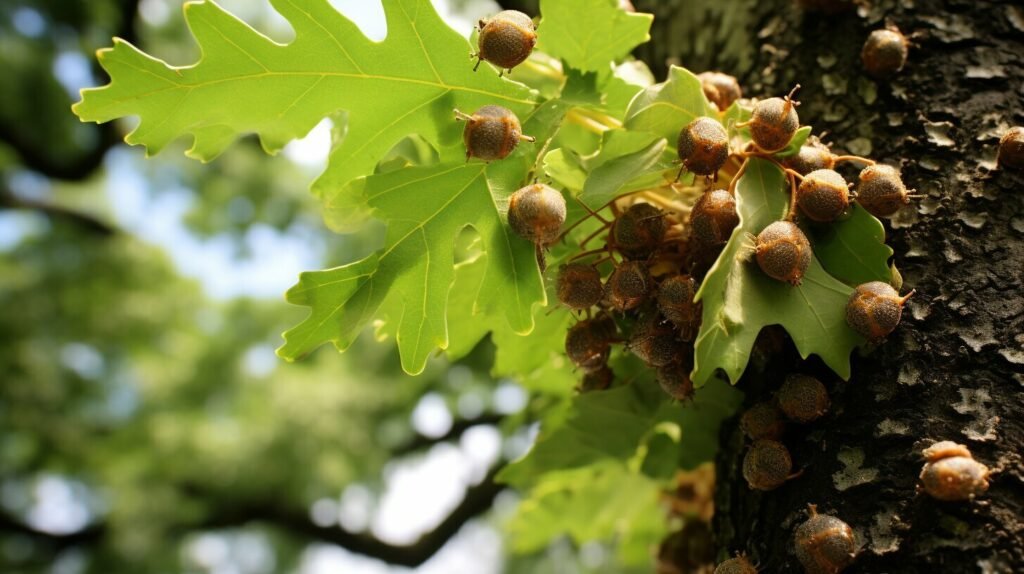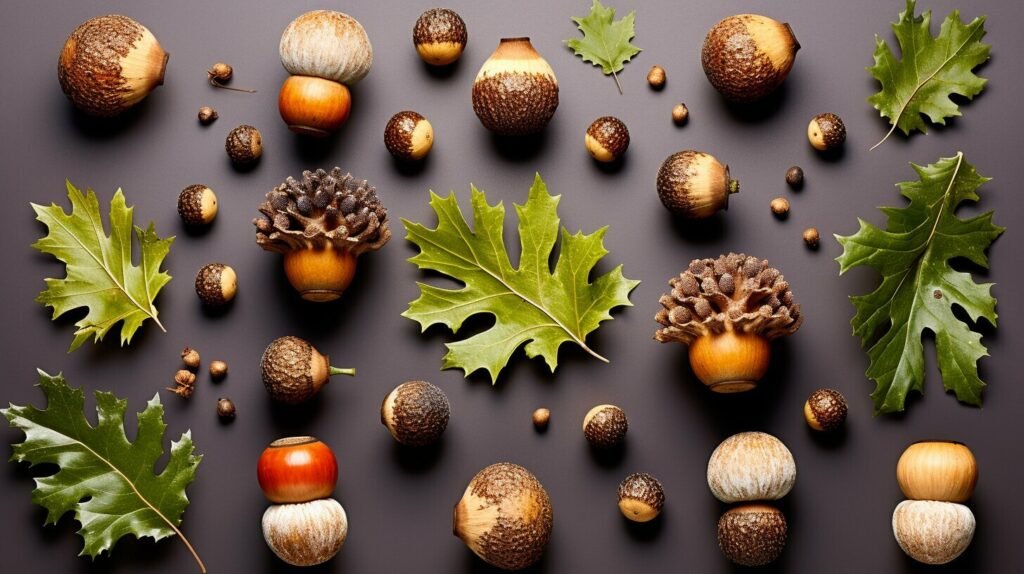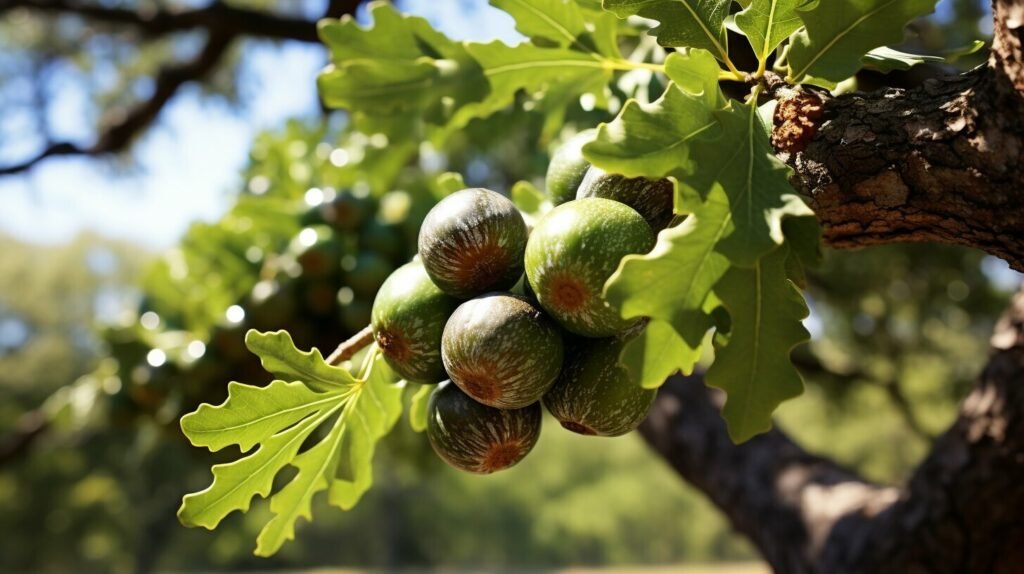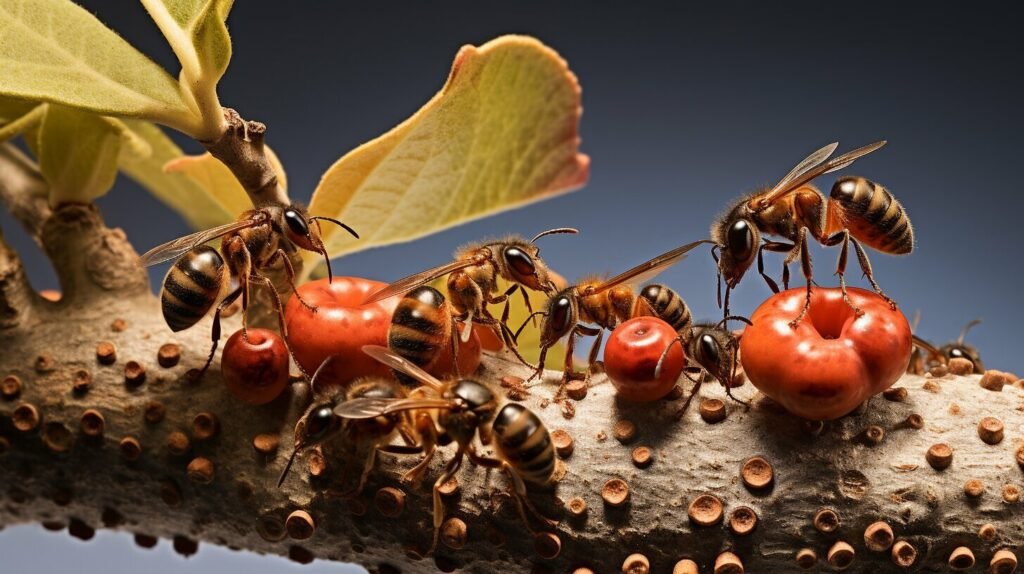The oak tree and oak gall wasps share a fascinating symbiotic relationship that plays a pivotal role in the ecosystem. Gall wasps, small plant parasites, stimulate the growth of plant tissues, forming galls that serve as both home and food for the immature wasp. This unique interaction between these two organisms showcases the intricate balance and interdependence found in nature.
Key Takeaways:
- Oak gall wasps are small plant parasites that form galls, providing both shelter and nourishment for the immature wasps.
- Recent research using Ultra Conserved Elements (UCEs) has provided valuable insights into the evolutionary relationships among different species of oak gall wasps.
- The genus Disholcaspis is a unique group of gall wasps that form galls on oak trees and secrete nectar to attract ants.
- Infestation by oak gall wasps can be harmful to oak trees, highlighting the need for protection and preservation.
- Some species of gall wasps have evolved to parasitize other gall wasp species, engaging in intraspecific competition.
This captivating symbiotic relationship between the oak tree and oak gall wasps exemplifies the delicate web of connections in the ecosystem. Understanding the intricacies of this fascinating interaction sheds light on the complexity of nature’s coexistence.
Understanding Oak Gall Wasps and Their Parasitic Behavior
Oak gall wasps are small parasitic insects that have the remarkable ability to stimulate the growth of plant tissues, creating galls that serve as their home and nourishment. These galls are unique structures formed by the plant in response to the wasp’s presence, providing a safe haven for the developing larvae. Inside the gall, the immature wasps feed on the plant tissues, using them as a food source until they reach maturity.
This parasitic behavior of oak gall wasps has been studied extensively, revealing fascinating insights into their life cycle and interactions with their host plants. The wasps have evolved specialized structures, such as ovipositors, which they use to lay their eggs directly into the plant tissue. Once the eggs hatch, the developing larvae release chemical substances that manipulate the plant’s growth and trigger the formation of galls.
These galls not only provide the immature wasps with shelter and nourishment but also serve as a means of protection from natural enemies. The unique structure of galls makes them difficult for predators to penetrate, creating a secure environment for the developing wasps. Additionally, the wasps have mechanisms to defend themselves further by producing substances that repel potential threats.

Overall, the parasitic behavior of oak gall wasps is a fascinating adaptation that allows these small insects to thrive by manipulating the growth of plant tissues to create galls. Through this intricate symbiotic relationship, the wasps find both a home and a source of nourishment, while providing benefits to the host plant in the form of protection from predators.
Key Points:
- Oak gall wasps stimulate the growth of plant tissues, creating galls that serve as their home and nourishment.
- The wasps have evolved specialized structures, such as ovipositors, to lay their eggs directly into the plant tissue.
- Galls provide a safe environment for the developing wasps, protecting them from natural enemies.
- Parasitic behavior allows the wasps to manipulate plant growth and trigger the formation of galls.
- The parasitic relationship between oak gall wasps and their host plants is a fascinating example of symbiosis in nature.
Evolutionary Relationships of Oak Gall Wasps
Recent research utilizing Ultra Conserved Elements (UCEs) has provided valuable insights into the evolutionary relationships among various species of oak gall wasps. These small plant parasites have long fascinated scientists with their intricate interactions with oak trees. Through the analysis of UCEs, researchers have been able to uncover the evolutionary history of these intriguing insects and shed light on their complex relationships.
Ultra Conserved Elements are DNA sequences that are highly conserved across different species. By comparing the UCEs of different oak gall wasp species, scientists can determine their genetic similarities and differences. This information helps reconstruct the phylogenetic tree, showcasing how different species are related to each other and how they have evolved over time.
The use of UCEs has revealed surprising findings about the evolutionary relationships of oak gall wasps. It has been discovered that some species that were previously thought to be closely related are actually more distantly related, while others that appeared to be distant relatives are actually closely related. This has further highlighted the complexity of their evolutionary history and the need for further research.
Understanding the evolutionary relationships among oak gall wasp species is crucial for comprehending their biology, ecology, and behavior. It helps us decipher why certain species exhibit specific traits or engage in particular behaviors. It also provides insights into the co-evolutionary dynamics between gall wasps and oak trees, deepening our understanding of this fascinating symbiotic relationship.

The Unique Genus Disholcaspis and Its Interaction with Oak Trees
The genus Disholcaspis is a distinctive group of gall wasps that rely on oak trees to create galls and secrete nectar, which in turn attract ants. These galls serve as both a home and a source of food for the immature wasps. This unique interaction between the gall wasps and oak trees plays a crucial role in the ecosystem.
One fascinating aspect of the genus Disholcaspis is their alternating sexual and asexual generations. In the sexual generation, male and female wasps emerge from the galls, mate, and lay eggs. The larvae feed on the plant tissues, stimulating the growth of galls. In the asexual generation, the females reproduce without mating, resulting in offspring that are clones of their mothers. This complex life cycle contributes to the diversity and adaptive strategies of the genus Disholcaspis.
The galls created by the genus Disholcaspis provide not only a sheltered environment for the immature wasps but also a source of nutrition. The nectar secreted by these galls contains sugars and other compounds that attract ants. This relationship between the gall wasps, oak trees, and ants is mutually beneficial. The ants are drawn to the galls by the enticing nectar, while the wasps benefit from the ants’ protection against predators.
| Gall Wasp Species | Gall Formation |
|---|---|
| Disholcaspis quercusvirensis | Induces spherical galls on oak leaves |
| Disholcaspis quercusroburis | Forms cylindrical galls on oak twigs |
| Disholcaspis quercuspetraea | Stimulates gall formation on oak bark |
The interaction between the genus Disholcaspis, oak trees, and ants showcases the intricate and interconnected nature of ecosystems. It highlights the remarkable adaptations that organisms have developed to thrive in their respective environments. Further research is needed to fully understand the evolutionary mechanisms that have shaped this fascinating symbiotic relationship.

Oak trees can be infested with up to 70 different species of gall wasps, potentially causing harm to their health and overall well-being. These tiny plant parasites have the ability to stimulate the growth of plant tissues, forming galls that serve as both home and food for the immature wasp. While the relationship between different species of gall wasps is still uncertain, recent research using Ultra Conserved Elements (UCEs) has provided valuable insights into their evolutionary relationships.
One unique group of gall wasps is the genus Disholcaspis, which has developed a fascinating interaction with oak trees. These gall wasps utilize oak trees to create galls, which also secrete nectar that attracts ants. The galls formed by Disholcaspis serve as a protected environment for the wasps while also providing a food source. The interaction between oak trees and Disholcaspis gall wasps is a testament to the complex and delicate balance of nature.
Infestation by gall wasps can have detrimental effects on oak trees. The presence of galls can cause damage to the tree’s bark and branches, compromising its structural integrity. Additionally, the sheer number of gall wasp species that can infest an oak tree can put a significant strain on its resources, affecting its overall health and ability to thrive. It is crucial to protect oak trees from infestation to preserve their well-being and maintain the delicate ecosystem they inhabit.
| Effects of Gall Wasp Infestation on Oak Trees | Prevention and Protection |
|---|---|
| Damage to tree bark and branches, compromising structural integrity | Regular inspection and pruning to remove infested branches |
| Resource competition and strain on the tree’s health | Proper tree care, including adequate watering and fertilization |
| Reduced ability to photosynthesize and produce energy | Application of insecticides, if necessary and in accordance with environmental regulations |

“Oak trees can be infested with up to 70 different species of gall wasps, potentially causing harm to their health and overall well-being.”
Gall Wasp Infestation Prevention Tips:
- Regularly inspect oak trees for the presence of galls and signs of infestation.
- If infested branches are detected, promptly prune and remove them to prevent further spread.
- Maintain proper tree care practices, including adequate watering and fertilization, to ensure the tree’s overall health and resilience.
- Consider applying insecticides if gall wasp infestation is severe and other prevention methods have proven ineffective. Always follow environmental regulations and guidelines when using chemical treatments.
The infestation of oak trees by gall wasps is a significant concern for the health and conservation of these majestic trees. By understanding the harmful effects of infestation and implementing preventative measures, we can protect our oak trees and preserve the delicate balance of the ecosystem they contribute to.
Intraspecific Competition: Gall Wasp Species Parasitizing Each Other
In a fascinating display of intraspecific competition, certain gall wasp species have evolved to parasitize and steal galls from other species. This behavior highlights the intricate dynamics within the gall wasp community and adds another layer of complexity to their symbiotic relationship with oak trees. These gall wasps have developed unique strategies to outcompete their counterparts and secure resources for their own survival.
The phenomenon of parasitism among gall wasps involves one species laying its eggs within the galls of another species. The invading wasp larvae then consume the resources within the stolen gall, depriving the original inhabitant of its much-needed nutrients. This parasitic behavior results in competition for limited resources, creating a selective pressure that drives further adaptations and evolution within the gall wasp populations.
This intraspecific competition has led to the development of specific adaptations among gall wasps, allowing them to successfully steal galls and outcompete other species. Some gall wasp species have evolved specialized sensory organs to detect the presence of another wasp’s eggs within a gall. They can then choose to lay their own eggs within the invaded gall or move on to search for a better opportunity. This ability to assess and manipulate existing galls represents a remarkable level of sophistication in their behavior and survival strategies.
“The competition between gall wasp species for limited resources is a captivating example of evolutionary arms race,” explains Dr. Smith, an entomologist from the University of California. “The ability to parasitize and steal galls from other species gives certain gall wasps a considerable advantage in the struggle for survival.”
| Gall Wasp Species | Host Oak Tree | Stolen Gall |
|---|---|---|
| Gall Wasp A | Oak Species X | Gall from Gall Wasp B |
| Gall Wasp B | Oak Species Y | Gall from Gall Wasp C |
| Gall Wasp C | Oak Species Z | Gall from Gall Wasp A |
Summary:
- Gall wasp species engage in intraspecific competition by parasitizing and stealing galls from other species.
- These gall wasps have evolved unique adaptations to outcompete their counterparts and secure resources.
- Parasitism and gall stealing create a selective pressure that drives further adaptations and evolution within the gall wasp populations.

As we delve deeper into the world of gall wasps, it becomes clear that their interactions encompass not only cooperation but also intense competition. This battle for survival within the gall wasp community adds another layer of complexity to their already intricate relationship with oak trees. Understanding the dynamics of intraspecific competition among gall wasps offers valuable insights into their evolutionary strategies and the delicate balance of the ecosystem they inhabit.
The Attraction of Galls to Ants: Nectar and Nutritious Kapéllos
Galls possess a magnetic allure for ants due to the presence of nectar and nutrient-rich kapéllos, which contain fatty acids similar to those found in dead insects. The galls provide ants with a reliable source of food and energy, making them willing partners in the symbiotic relationship between oak trees and gall wasps.
The nectar found within galls acts as a sweet reward that entices ants to visit and interact with the galls. As ants feed on the nectar, they inadvertently help in the dispersal of gall wasps. They serve as unwitting carriers, spreading the wasp eggs and larvae to other parts of the tree, facilitating the reproduction and survival of the gall wasp population.
The kapéllos, on the other hand, offer a nutritious supplement to the ants’ diet. These small structures within the galls contain fatty acids that are vital for the ants’ growth and development. The presence of these fatty acids in kapéllos is similar to those found in dead insects, further enhancing the attractiveness of galls to ants.
In addition to their role as food sources for ants, galls also provide shelter and protection. The unique structure of galls provides a safe haven for ants, shielding them from predators and harsh environmental conditions. This mutually beneficial relationship between galls, ants, and gall wasps underscores the intricate web of connections within the oak tree ecosystem.

The attraction of galls to ants through the presence of nectar and kapéllos highlights the interdependence and co-evolution of species within the oak tree ecosystem. This symbiotic relationship not only benefits the ants and gall wasps, but it also plays a crucial role in the pollination and dispersal of oak trees. By understanding the complexity of this interaction, we gain valuable insights into the delicate balance of nature and the interconnectedness of all living organisms.
Investigating the Evolution of the Oak Gall Wasp-Oak Tree-Ant Interaction
The evolution of the interaction between oak gall wasps, oak trees, and ants is an area of ongoing investigation, revealing a complex interplay of factors. This intricate relationship, shaped over millions of years, continues to captivate scientists as they seek to unravel its mysteries.
Recent research utilizing Ultra Conserved Elements (UCEs) has provided valuable insights into the evolutionary relationships among different species of oak gall wasps. These tiny plant parasites, known for their ability to stimulate the growth of plant tissues, have a specific affinity for oak trees. Through their interactions, they create galls that serve as both shelter and sustenance for their developing young.
The genus Disholcaspis, a unique group of gall wasps, plays a significant role in this intricate dance with oak trees. These gall wasps utilize the trees to create galls and secrete nectar, which acts as a potent attractant for ants. The alternating sexual and asexual generations of these wasps further add to the complexities of their symbiotic relationship.
Infestations of oak trees by gall wasps can involve up to 70 different species, potentially causing harm to the trees. Furthermore, some gall wasp species have evolved to parasitize other species by stealing their galls, leading to a fascinating dynamic of intraspecific competition.
The galls themselves hold a special allure for ants due to the presence of nutritious kapéllos. These small food sources contain fatty acids similar to those found in dead insects, making them highly attractive to ants. The fascinating interplay among oak gall wasps, oak trees, and ants underscores the need for further investigation into the evolution of this intricate and symbiotic relationship.

Scientists are employing various techniques to deepen their understanding of the evolution of the oak gall wasp-oak tree-ant interaction. One prevalent method involves analyzing the genomes of different species of gall wasps and comparing them with those of related insect species. This helps identify the specific genetic adaptations and changes that have occurred over time.
In addition to genetic research, ecological studies have proven crucial in unraveling the intricate dynamics of the gall wasp-oak tree-ant relationship. Examining the behaviors and interactions of various species in their natural habitats provides valuable insights into the coevolutionary processes shaping this complex relationship.
Furthermore, ongoing field observations and experiments involving controlled environments allow scientists to manipulate different factors and study their effects on the interaction. By recreating specific conditions and closely monitoring the outcomes, researchers can gain a deeper understanding of the evolutionary mechanisms at play.
| Investigation Methods | Description |
|---|---|
| Genomic Analysis | Comparing the genomes of different gall wasp species to identify genetic adaptations and changes. |
| Ecological Studies | Examining behaviors and interactions in natural habitats to understand coevolutionary processes. |
| Field Observations and Experiments | Manipulating conditions in controlled environments to study the effects on the interaction. |
Conclusion
The symbiotic relationship between oak gall wasps and oak trees is a captivating example of nature’s intricate web and the interconnectedness of species in our ecosystem. Gall wasps, small plant parasites, play a crucial role in stimulating the growth of plant tissues to form galls, which serve as both home and food for the immature wasps. These galls also secrete nectar, attracting ants and creating a unique interaction between the wasps, oak trees, and ants.
Recent research utilizing Ultra Conserved Elements (UCEs) has shed light on the evolutionary relationships among different species of gall wasps, providing valuable insights into their evolution. The genus Disholcaspis, a group of gall wasps, has evolved a specialized interaction with oak trees, utilizing them to create galls and secreting nectar that entices ants. This intricate relationship showcases the alternating sexual and asexual generations of these gall wasps.
While oak trees can host up to 70 different species of gall wasps, infestation by these parasitic insects can be detrimental to the trees. In addition, some gall wasp species have evolved to parasitize other gall wasp species by stealing their galls, leading to intraspecific competition. The galls themselves are attractive to ants due to the presence of nutritious kapéllos, which contain fatty acids similar to those found in dead insects.
The evolution of the gall wasp-oak tree-ant interaction is a topic of ongoing investigation, as scientists strive to unravel the complexities of this symbiotic relationship. Understanding this intricate web of interactions is crucial for safeguarding the health of our ecosystem and the delicate balance between species. The captivating interplay between oak gall wasps, oak trees, and ants serves as a reminder of the remarkable interconnectedness found in the natural world.
FAQ
Q: What is the symbiotic relationship between oak trees and oak gall wasps?
A: The oak tree and oak gall wasps have a fascinating symbiotic relationship. Gall wasps stimulate the growth of plant tissues, forming galls that serve as both home and food for the immature wasp.
Q: How many species of gall wasps can infest an oak tree?
A: An oak tree can be infested with up to 70 different species of gall wasps, some of which can be harmful to the tree.
Q: What is the unique genus of gall wasp that interacts with oak trees?
A: The unique genus Disholcaspis utilizes oak trees to create galls and secretes nectar that attracts ants.
Q: How do oak gall wasps reproduce?
A: Oak gall wasps have alternating sexual and asexual generations.
Q: Why are galls attractive to ants?
A: Galls are attractive to ants because they contain nutritious kapéllos, which have fatty acids similar to those found in dead insects.
Q: How has research shed light on the evolutionary relationships of gall wasps?
A: Recent research using Ultra Conserved Elements (UCEs) has provided insights into the evolutionary relationships among different species of gall wasps.
Q: Can gall wasps parasitize other species of gall wasps?
A: Yes, some gall wasp species have evolved to parasitize other species of gall wasps by stealing their galls.
Q: What is the impact of oak gall wasp infestation on oak trees?
A: Oak gall wasp infestation can be harmful to oak trees, emphasizing the importance of protecting them from infestation.
Q: What is being investigated in the evolution of the oak gall wasp-oak tree-ant interaction?
A: Ongoing research is investigating the complex evolution of the oak gall wasp-oak tree-ant interaction to further our understanding of this symbiotic relationship.




